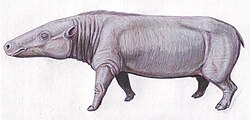Our website is made possible by displaying online advertisements to our visitors.
Please consider supporting us by disabling your ad blocker.
Anthracotheriidae
| Anthracotheriidae Temporal range:
| |
|---|---|

| |
| Anthracotherium | |
| Scientific classification | |
| Domain: | Eukaryota |
| Kingdom: | Animalia |
| Phylum: | Chordata |
| Class: | Mammalia |
| Order: | Artiodactyla |
| Suborder: | Whippomorpha |
| Superfamily: | Hippopotamoidea |
| Family: | †Anthracotheriidae Leidy, 1869 |
| Genera and subfamilies[1][2] | |
Anthracotheriidae is a paraphyletic family of extinct, hippopotamus-like artiodactyl ungulates related to hippopotamuses and whales. The oldest genus, Elomeryx, first appeared during the middle Eocene in Asia. They thrived in Africa and Eurasia, with a few species ultimately entering North America during the Oligocene. They died out in Europe and Africa during the Miocene, possibly due to a combination of climatic changes and competition with other artiodactyls, including pigs and true hippopotamuses.[3] The youngest genus, Merycopotamus, died out in Asia during the late Pliocene, possibly for the same reasons. The family is named after the first genus discovered, Anthracotherium, which means "coal beast", as the first fossils of it were found in Paleogene-aged coal beds in France. Fossil remains of the anthracothere genus were discovered by the Harvard University and Geological Survey of Pakistan joint research project (Y-GSP) in the well-dated middle and late Miocene deposits of the Pothohar Plateau in northern Pakistan.[4]
In life, the average anthracothere would have resembled a skinny hippopotamus with a comparatively small, narrow head and most likely pig-like in general appearance.[5] They had four or five toes on each foot, and broad feet suited to walking on soft mud. They had full sets of about 44 teeth with five semicrescentric cusps on the upper molars,[3] which, in some species, were adapted for digging up the roots of aquatic plants.[6]
- ^ Kron, D.G., B.; Manning, E. (1998). "Anthracotheriidae". In Janis, C.M.; Scott, K.M.; Jacobs, L.L. (eds.). Evolution of Tertiary mammals of North America. Cambridge: Cambridge University Press. pp. 381–388. ISBN 978-0-521-35519-3.
- ^ Lihoreau, Fabrice; Jean-Renaud Boisserie; et al. (2006). "Anthracothere dental anatomy reveals a late Miocene Chado-Libyan bioprovince" (PDF). Proceedings of the National Academy of Sciences. 103 (originally published online May 24, 2006): 8763–7. Bibcode:2006PNAS..103.8763L. doi:10.1073/pnas.0603126103. PMC 1482652. PMID 16723392.
- ^ a b "Anthracotheriidae (Family)". Archived from the original on 2009-03-19. Retrieved 2009-04-30.
- ^ [], Chaire de Paléoanthropologie et de Préhistoire, Collège de France, 11 place Marcelin Berthelot, 75005 Paris, France Copyright 2007 The Palaeontological Association
- ^ Allaby, Michael (1999). "Anthracotheriidae". A Dictionary of Zoology. Encyclopedia.com. Retrieved 15 Apr 2009.
- ^ Douglas Palmer (1999). Barry Cox (ed.). The Marshall Illustrated Encyclopedia of Dinosaurs and Prehistoric Animals. London: Marshall Editions. p. 268. ISBN 978-1-84028-152-1.
Previous Page Next Page


